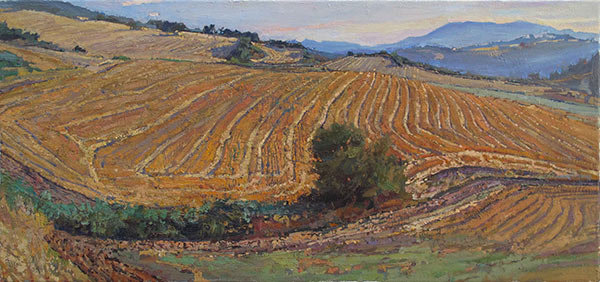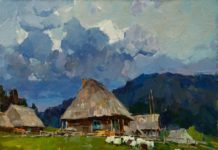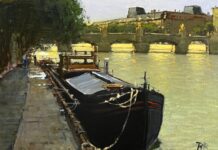The winner of the April-May contest in the PleinAir Salon has many thoughtful things to say about art and process, but when you ask him what he most wants to instill in his paintings, the answer is quite brief.
“I want a painting to have beauty and dignity, more than anything,” says Daud Akhriev. “I appreciate these qualities in music, cinematography, and dance … beauty and dignity.”
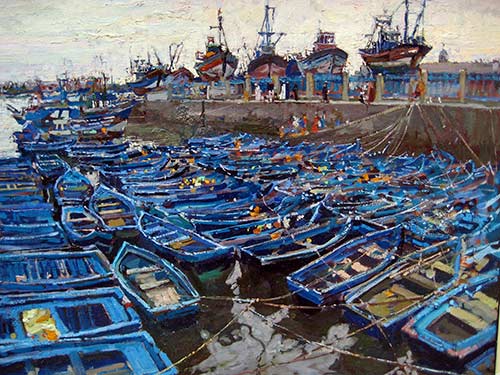
“Blue Boats, Essaouira,” by Daud Akhriev, oil on board, 16 x 20 in. Private collection
He and his wife, Melissa Hefferlin — who’s also an artist — split their time between Tennessee and Andalusia, Spain, and it’s in the latter location where Akhriev painted the piece that won him the top spot in the PleinAir Salon contest. “My wife and I have moved to Andalusia for much of each year, and this view is from the terrace of the village church in the town where we have studios,” says Akhriev. “I wanted to paint that view from the church because of the way the village spreads out below like a carpet. I liked the white city with the red rooftops of weathered tiles, with stone formations around. The cools and warms are particularly beautiful at sunset, especially the whites and reflections within a white village, where some walls are warm and some walls are cool, making a mosaic of the planes. There was drama of cool shadows and warm evening light. The bouncing light, the reflections within the shadows, was very dramatic and beautiful. In the chaos you still see the way the streets move throughout the village.”

“Andalusian Rooftops,” by Daud Akhriev, oil, 22 x 30 in. First Place in the April-May contest of the PleinAir Salon
Akhriev’s son, Timur Akhriev, has clearly learned some good lessons from his father; Timur won the top spot in the February-March contest of the PleinAir Salon. And though Timur says he was influenced by his stepmother’s color sense, bold tones are evident in both father’s and son’s paintings. The pieces are fascinating just for their suggested color philosophy.
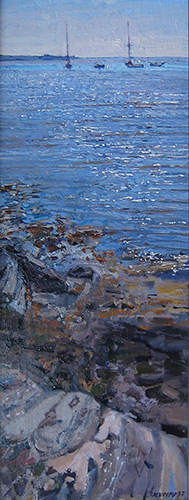
“View From Mill House,” by Daud Akhriev, oil on gessoed board, 12 x 5 in.
“What’s important about color is the relationship of the color on the canvas,” says Daud Akhriev. “There is no ugly color, only unsuccessful relationships. In this way plein air is a very important teacher. For example, there are many times when you start a painting one way and then the sun moves and you see how your original idea for the landscape could be so much more amazing. Today in my painting here in St. Petersburg [Russia], where I am staying, the sun changed to an intense rosy glow, and everything in my composition changed and melted. It was an amazing harmony of color relationships. My philosophy is to find those relationships. I also generally believe that in any painting there should be a bit of color that is a soloist, and finding that area is a great satisfaction when it comes out well.”
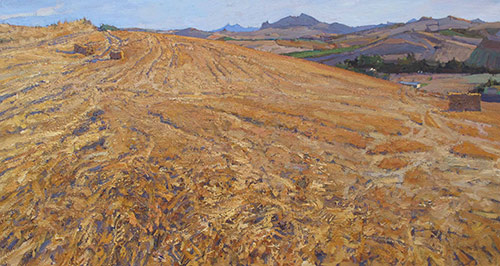
“The Wheat Fields of Torre Alhaquime,” by Daud Akhriev, oil on linen, 19 1/2 x 36 in.
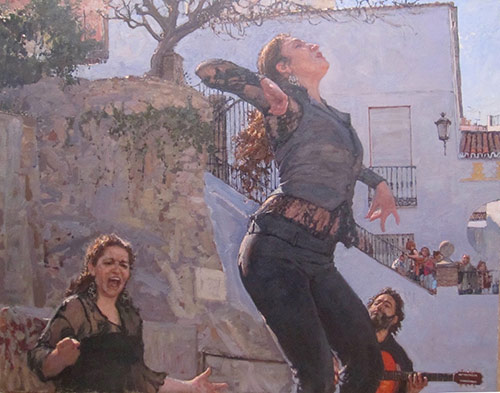
“Crescendo,” by Daud Akhriev, oil on linen, 26 x 29 in.
Father and son are both also interested in depicting the laborers in society. “I am feeling drawn to people in these recent months,” says Daud Akhriev. “I am excited to work with people. These days so often people in our culture want to avoid work, or labor. They want success quickly, easily. I am interested in laborers: fishermen, builders, craftsmen. I also believe that great painting often takes a lot of time. I would like to show that there is a beauty and dignity in labor, when one does well any job that is meaningful. There is joy when a project succeeds. There is learning when a project fails, but even then, the process is beautiful. So my goal is to do a series of paintings on labor. Some workers will be in nature, some will be within interiors. I have been gathering materials on the subject.”
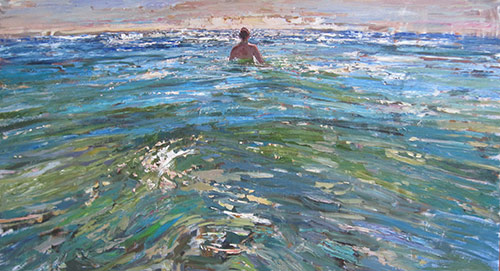
“The Swimmer,” by Daud Akhriev, oil on linen, 40 x 72 in.
Akhriev also works in pastel, and his tile murals are absolutely ravishing. But he says plein air painting remains instrumental to his process. “I can’t imagine doing anything in art without plein air painting because for me they are inseparable,” he says. “In fact, anywhere we go, the first thing we do is life studies. When you work a lot from your head in the winter, using the materials you gathered in the summer, when you are again in spring or summer or fall when you can paint outside, it always refreshes your eyes. Any subject absorbs so much from the light and color in the surroundings, so that in fact all painting pulls from plein air.

“Venetian Cerulean,” by Daud Akhriev, oil on gessoed wood, 8 x 23 3/4 in. Collection of Gary Smith
“Once I had an analysis from one of my friends who attended an exhibition I hung with another painter. The visitor said, ‘It’s so easy to tell who paints plein air frequently, because in the work of artists who paint frequently from life, the shadows don’t repeat themselves identically.’ I also want to say about painting plein air, that the time standing in one place trains the eye to see extreme subtleties that do not present themselves in a swift glance.
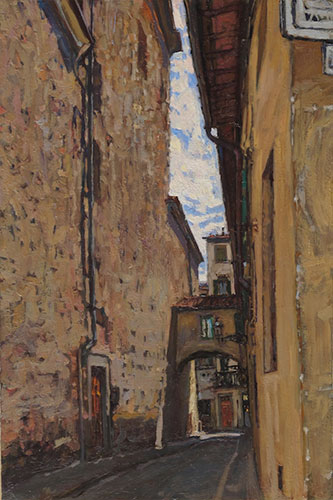
“High Passage,” by Daud Akhriev, oil on gessoed wood panel, 11 3/4 x 7 3/4 in.
“Mainly I want to say that plein air is the single most helpful tool to understand subtlety. It teaches about rough and soft edges, and color relationships.”

